 |
Saunders County(Part 2) |
This is a NEGenWeb Project web page
and is presented as part of the
MARDOS Memorial Library Collection.
Saunders County
(Part 2)
|
(Data furnished by Frank Kaplan, Morse Bluff). The first Czech to come into this part of the county was Anton Hajek, who in 1867 took a homestead in the valley between the Platte river on the north and the chain of hills on the south, between Morse Bluff and Linwood. Can we, even in imagination, place ourselves in the position of an immigrant coming to a bare prairie, where the nearest neighbor is several miles away, with whom he cannot converse anyhow, not knowing the language? He must build a shelter. Of what? With what? A dugout in the bank, covered with brush and sod must do. No roads, no bridges, nothing to eat. 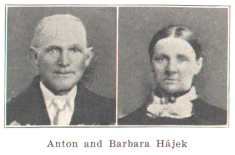
Most of the Czechs in this vicinity were obliged to go elsewhere to earn a living. Many originally came (in this country) from around Braidwood, Illinois, where they had worked in mines. So back there they went for the winter season, or to Omaha (and in either case they went to Omaha afoot), leaving their wives to take care of the children and homesteads. Mrs. Frank Hines (living at date of writing) remembers when her husband left for Braidwood and two weeks later their son Frank was born. There was no alternative, they had to live. Mrs. Rosalie Soukup (born Datel), another pioneer still living, says: "I experienced a great scare when two Indians came into my house and stood by the cradle, where lay our youngest. My husband had hidden several hundred dollars in currency in the clock, he was going to pay for a threshing machine. But nothing happened, the Indians left in peace. That was in 1876 or 1877.1 came here with my parents in 1867 and entered service in the family of Mr. Jilek (Ellick) in Fremont. Their physician was Dr. Brunner, and he thus came to know who I was. A few years later, after I had been married and was farming with my husband, I felt weak and worn. My husband took me to Fremont, to see the doctor, the same Dr. Brunner. He examined me, wrote a long prescription and told me to take it to the store. How surprised and delighted I was to find that the "prescription" was an order for beans, onions, apples, rice, cheese and other provisions, which the generous and kindly doctor, noting my undernourished condition, had prescribed and paid for. Such were our beginnings." --Another pioneer, Mrs. M. Janovec, remembers when they had nothing for weeks but ground corn meal, no fat, no milk. From 1867 to 1871 the nearest mill was in Ashland, later in Wahoo. There were no roads and oxen were used, so that the trip to and from Ashland, 49 miles, lasted a week. Indeed, there were instances when the earliest pioneers, having no teams of any kind, walked both ways. The nearest town was Fremont, eighteen miles away from Morse Bluff and about twenty-five miles from the center of the colony then forming. All products were taken there and all provisions and supplies hauled from there. During the first years products were scanty, for but small areas of ground had been broken and planted by hand. A trip to Fremont with products lasted a day and part of the night, longer in bad weather. North Bend already existed on the other side of the Platte river, but there was no bridge. The river could be crossed in very cold weather, when frozen, but it was not always safe. In the summer a ferry operated and often was stranded on a sandbar, when the passengers were obliged to spend the night there, sometimes in a storm. Wintry and stormy weather proved a great hardship, for shelters for men and beasts were insufficient, often none at all for the latter. Hay for horses had to be pulled from stacks, they had no haymows. Mr. John Haba, Mr. Kaplan's father-in-law, who used to farm near Rescue and now lives in Morse Bluff, says: "We had two oxen, all we had, and they had been for almost two days snowed in by the straw pile. What to do? How could we get along without them, if they froze? There was no other help but to take them into the sod house. It was not pleasant, but there was no other alternative."
1867--The Following Came: Anton Hajek, born in Tesovice, Plzen, 1823, died May 23, 1909; John Savlik, Cernikov. Joseph Datel, Kolec near Praha. A blacksmith, plied his trade on his farm two miles south of Morse Bluff, later in North Bend. Died July 6, 1902. His wife still living and his son a prominent business man of North Bend. 1868--The Following Came: Thomas Killian, born 1824 in Janovice. Came to Pittsburgh, Pa. with family in 1866. He soon learned English and was adviser and friend to newcomers, giving them shelter before they prepared one for themselves. He died May 21, 1882. His sons and grandsons are members of the well-known firm Killian Bros., having large stores in Wahoo, Cedar Bluffs and Cedar Rapids, Iowa. Jacob Franta, Mlynec, Plzen, Aug. 10, 1838, died Aug. 15, 1914; Anton Cippera, born 1841, Nezor, Nova Kdyne, came to Omaha in 1867, died Dec. 1, 1918; Anton Cuhel, born Nov. 9, 1817, died August 18, 1894; Thomas Mares, born in Bezdekov, Klatovy. 1869--The Following Came: Matej Racek, Breskovice, Plzen, Jan. 6, 1818, came with five sons to Iowa in 1861. Died June 2, 1900. Vaclav Racek, Breskovice, Plzen, Nov. 27, 1849, came with father to Iowa in 1861, died Nov. 18, 1908. Frank Beznoska, Beroun. Came to Cleveland in 1865. Died March 3, 1900, aged 78. Remembered as an able ferryman, who saved people from drowning on several occasions. John Janovec, Strejckovice, July 6, 1849, died January 30, 1901. Anton Fiala, Janovice 1838, died Oct. 28, 1907. 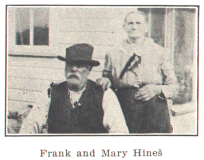
Vaclav Hajek, Tesovice, 1825, died Nov. 15, 1892. Joseph Pabian, Drazek near Zahorany, Sept. 26, 1844, died Sept. 8, 1908. Vaclav Nesladek, 1834, Bousov, Caslav, died 1919. A veteran of the Austrian army, taking part in the wars with Italy in 1859 and 1866. John Pabian, Zahorany, died Feb. 8, 1894, aged 58. 1870--The Following Came: Volfgang Eckstein, born 1819, came to Pittsburgh in 1868. Died within a few days of 100 years of age. Born in Bujanov, Klatovy. John Beranek, Bracice, Caslav, 1844. Came to Wisconsin in 1863. Living at time of writing. Vaclav Bures, Pretin, County Klatovy, 1833, died Feb. 4, 1906. 1871--The Following Came: John Zakovec, Koryta, Plzen, came to Braidwood in 1870. Died Nov. 2, 1922. 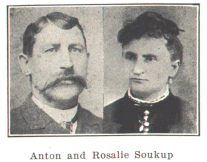
Anton Soukup, Koryta, 1850, to Braidwood in 1870, died March 15, 1910. Active in national and political life. Joseph Hines, Koryta, December 1845, came to Braidwood in 1867. Living at date of writing. Frank Hines, Koryta, came to Braidwood in 1870. His son was county clerk, at present postmaster in Wahoo. John Virka, Kacerov, Dec. 1847, to Braidwood 1870, died Feb. 3, 1922. John Ruzicka, Jarov near Kralovice, came to Braidwood in 1870, died August 17, 1920. John Svarc, born 1833, died 1897. Birthplace unknown. Anton Somer. Removed to Beemer, Nebr. Frank Mizera, born in Obora, Kralovice. Frank Levy, birthplace unknown. All of these who came in 1871 were miners and used to go back to Braidwood to work. With them returned to Nebraska newcomers, who used to go to Saline and Fillmore Counties to earn money for necessities, there being older Czech settlements there, and therefore a chance to work. Vaclav Cerny, born in Cernikov, June 21, 1827, died April 24, 1902. His son is a member of Cherney & Watson Lumber Co., operating in several towns of Nebraska and Iowa. His granddaughter Emily is a public school teacher and Helen teaches music. John Vyhlidal, Slavetice, Moravia, June 24, 1825, died Nov. 19, 1909. A good friend of Vaclav Cerny and Thomas Killian, with whom he held Sunday services in homes, before churches or lodges existed. For many years officiated at funeral services. Joseph Roubal, Oboci, Plzen, Nov. 30, 1851, living. Vaclav Burda, Lomnicka, 1843, died June 21, 1910. 1872--The Following Came: John Walla, Sermikovice, Moravia, died July 9, 1906, aged 84. His four sons came with him and as he had more means than most, he was able to help the needy ones. His grandsons are in business in Morse Bluff. John Kavan, born in Chudenice, October 15, 1849, living. Jacob Jelinek, Sermikovice, 1829, died in 1873. Killed by accident while hauling lumber from Fremont. 1874--The Following Came: Frank Vopalensky, Novy Rychnov, April 2, 1819, to Wisconsin in 1862, died April 30, 1906. His son Frank was member of the legislature 1907--1908. 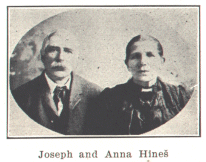
Joseph Hines, Koryta, March 12, 1823, died Oct. 11, 1906. John Hines, his son, living in Prague. Anton Ondracek, born in Valec, Moravia, 1845, died 1894. Charles Vesely, born in Zak, County Caslav, 1816, came to Wisconsin in 1864, died in 1887. Buried in Sand Creek cemetery, all the others in Bohemian (Killian) cemetery, Ceskoslovensky (Czechoslovak) Cemetery or Cedar Hill Catholic Cemetery. 1875--The Following Came: John Kavan, born Dec. 25, 1851 in Blatna, Moravia. 1878--Following Came: Jacob Savlik, born in Cernikov 1841, died in Linwood, Dec. 4, 1925. 1880--The Following Came: Joseph Beranek, Bracice, 1855, came to Wisconsin in 1863, living. Other old settlers, the date of whose coming is uncertain: Jacob Dvorak, Kamenna, Trebic, April 22, 1848 died Feb.17, 1893, Matyas (Mathias) Nesladek, father of Vaclav, Bousov, Caslav; Thomas Novak, Bacice, Krumlov, Nov. 19, 1819, died Jan. 8, 1900; John Baur, Spanov, Domazlice, died Jan. 6, 1913, aged 82; Martin Mahlik, Tlumacov, Do mazlice, 1828, died 1925; Joseph Chmelka, Slavetice, Krumlov, Nov. 17, 1867, died Jan. 1901; Frank Soucek, Podmokle, Zbirov, 1840, died 1916; Joseph Hamrdla, Prisbach, Mor. Budejovice, 1837, died 1907; Joseph Brozovsky, born May 1813, died Jan. 1900, birthplace unknown; Frank Mizera, born in Obora, Kralovice, died Sept.29, 1894; Frank Vojtech, born in Lukov, Mor. Budejovice, Nov. 7, 1839, died Dec. 27, 1922; Vaclav Satorie, Podmoky, Caslav, Nov. 14, 1839, died Jan. 29, 1922; Matyas (Matthias) Kroupa, born 1816, died 1895; Anton Pernicka, Vanice, Brno, Moravia, June 18, 1866, died May 12, 1913; Matej Tomasek, born in Plzen County, died 1887, aged 46; Frank Babka, 1849--1917, birthplace unknown; Frank Bobek, Zhorov, Caslav, died May 1908, aged 70; Vaclav Kunes, Uboc, Nova Kdyne, died August 2, 1910, aged 80; Vaclav Kohout, born 1855 in Nemcice, County Nova Kdyne came in 1872, lived here a year and a half, then returned to Bohemia and came again in 1880, when he settled near Valparaiso. Mr. Frank Meduna, an old settler in Weston, writes: 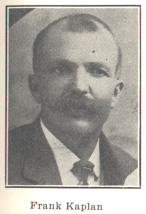
"I remember when cowboys herded cattle by the thousands. Between my father's farm and Valparaiso, a distance of nine miles, but two sod houses could be seen. A herd numbered from two to three thousand head, for as late as 1881 for twenty miles to the south of us all was unsettled, with few exceptions. The Overland Trail was but a quarter of a mile distant from our farm, and to this day the ground over which it wound is not as fertile, for there were about twenty wheel ruts in it and the rains washed everything away. My old friend George Hejtman, who settled in this vicinity in 1868 and who died in 1925, at the ripe age of eighty (buried in Weston) related to me some of his experiences. He came to Cedar Rapids, Iowa, in 1867, from County of Plzen. At first he worked on a farm and later went to Omaha, then a small town. He worked on the Union Pacific bridge construction there and cut fire-wood on a timbered island, the same being used by steamboats. When work grew scarce, with his friend Martin Jansky he went to Wyoming, to work on the Union Pacific Railroad. However, the labor was heavy in those waste lands, the food bad and the alkali water unfit for drinking, so that many became ill. When they were working in Laramie, Hejtman grew worse and with Jansky decided to return to Omaha. They had but little money, so were obliged to go afoot several hundred miles. Hejtman had two pairs of shoes, both of which were worn out before they reached their destination. They suffered hunger and thirst, for there was no food or water to be had on the plains, except when they reached a fort. These forts were made of logs, covered with sod, and were quite a distance apart from each other. They were built for the railroad laborers, for safety against Indians. 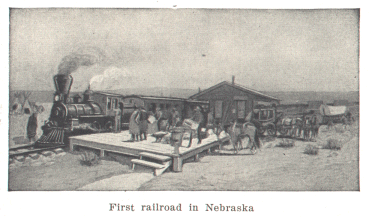
After many weeks' travelling and great suffering, they reached Omaha, where Hejtman sought a physician, who could not do much for him. V. L. Vodicka advised him to take a tablespoon of salt in water, which he did twice and was cured. He worked a while in Omaha and when he had saved a little money, married Anna Karlik and moved to Saunders County, where he took a claim five miles northwest of the present town of Weston, in the spring of 1868. He made a dug-out, covering it with slough grass, and the "palace" was ready for occupation. Mrs. Hejtman received a few chickens from friends and that was all their live stock. A neighbor who owned a team broke their sod, but Hejtman had to go to Omaha (sixty miles) afoot, to work and earn some money. He bought a cow and drove her from Omaha via Fremont. As the water was high, the ferry there was in bad shape and so he had to wait several days. But when he arrived with the cow, his wife's joy was great. When he had earned enough money to buy a team, conditions began to improve. However, markets and mills were far away. Fremont over thirty miles, Ashland (where the mill was) that far also. The roads were poor, no bridges, the journey required two or three days. Prairie fires, grasshoppers, chinch bugs, -- all these served to ruin the crops of the poor beginners. When the Union Pacific railroad built from Valley through Wahoo in 1876, and through Weston to Lincoln, prosperity came and settlers poured in. Martin Jansky is living at date of writing, in Weston, over eighty years old, but still hale and hearty." |
| Back | Table of Contents | Next |